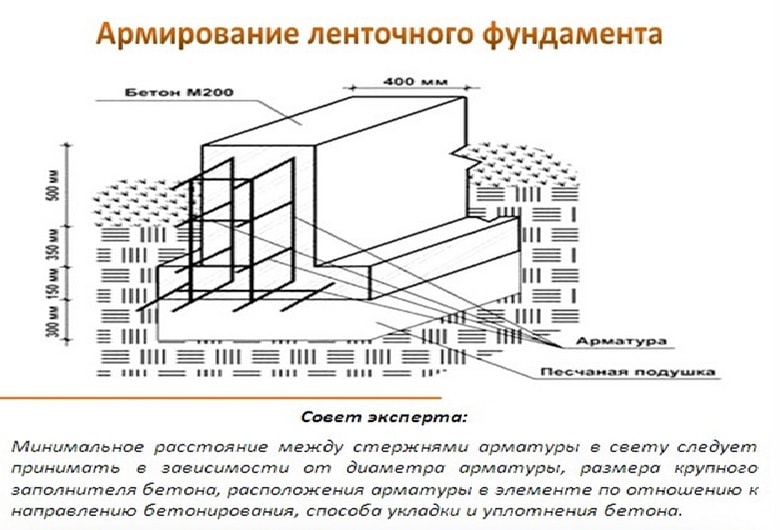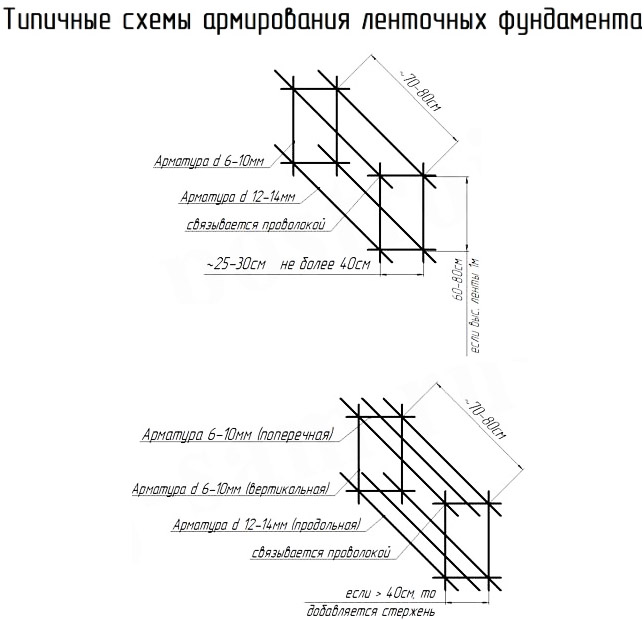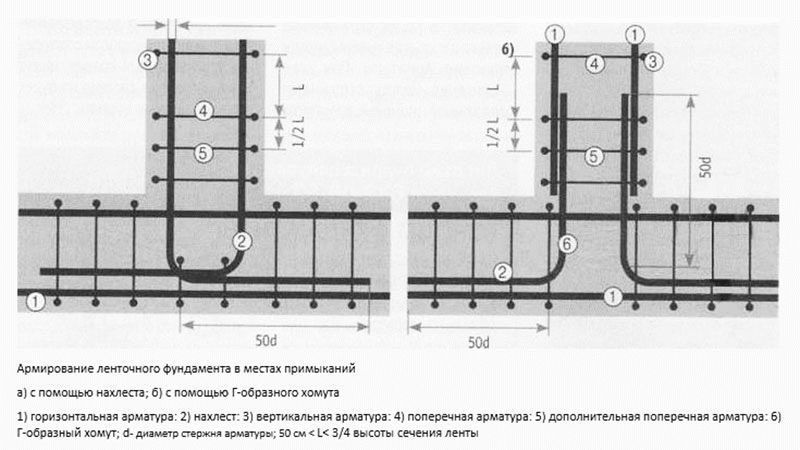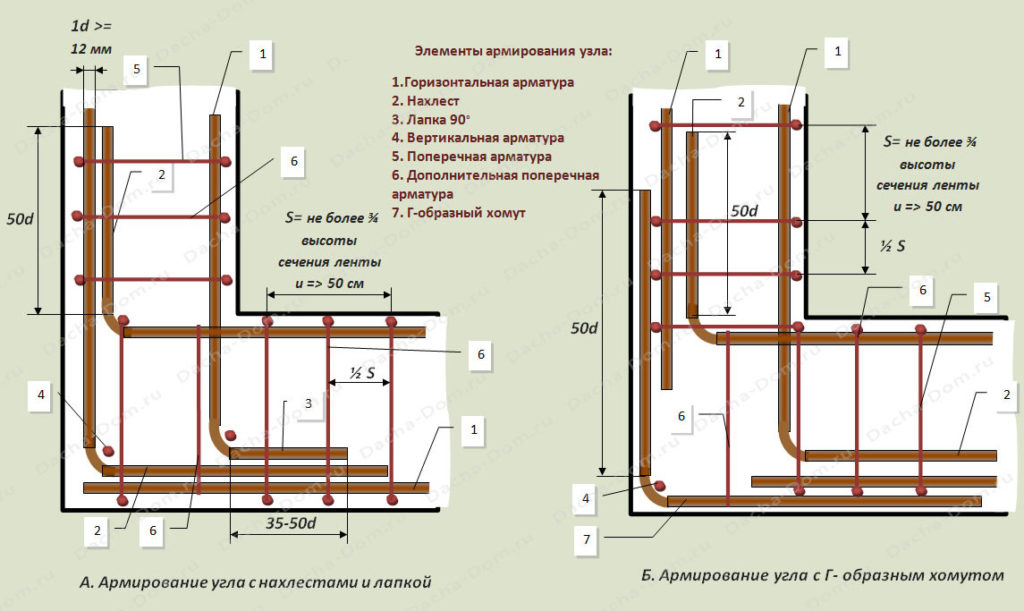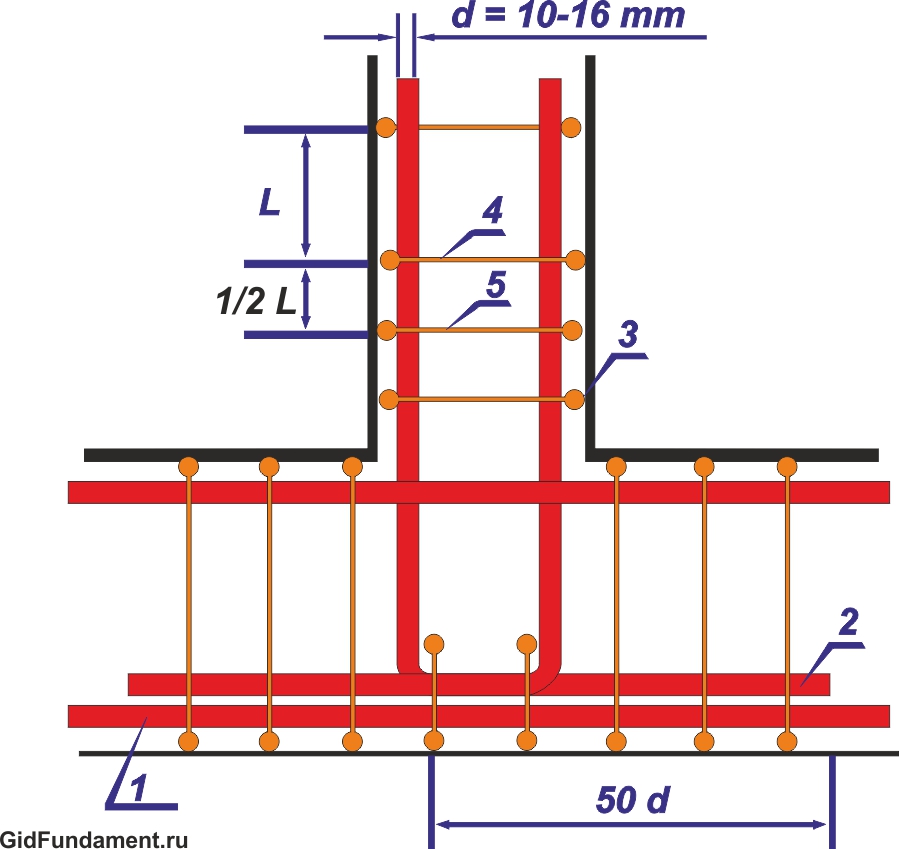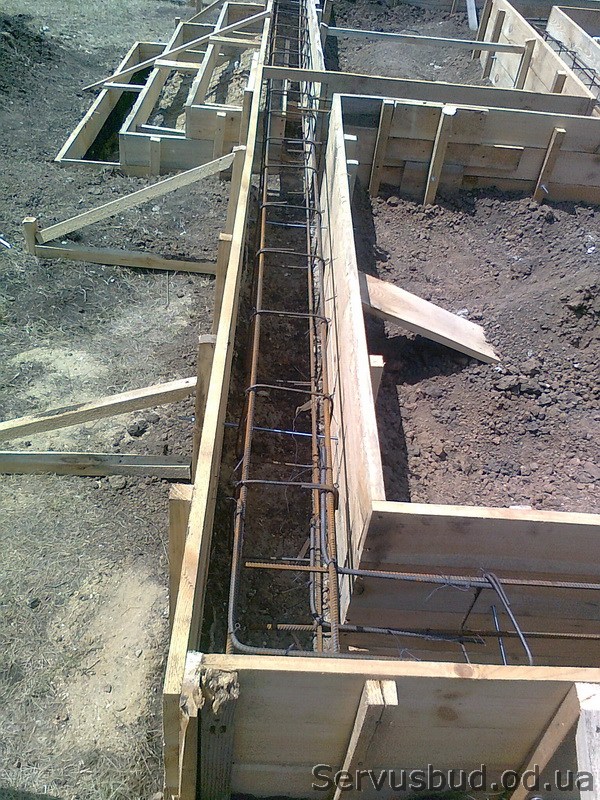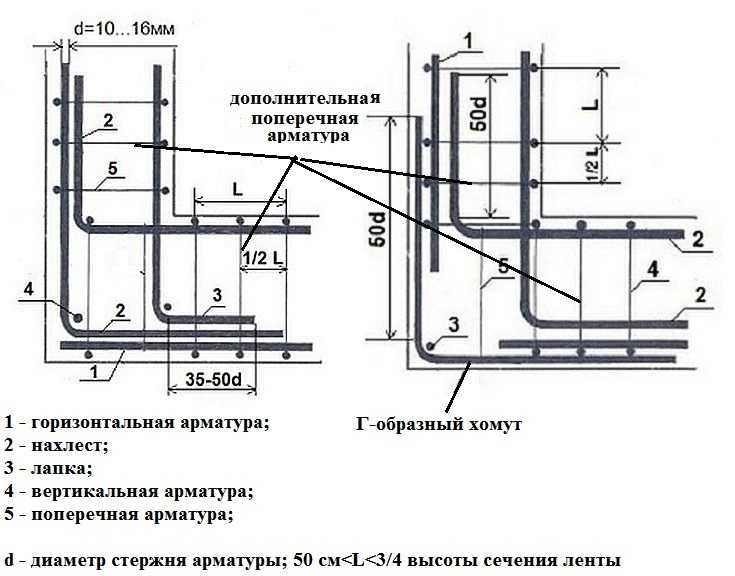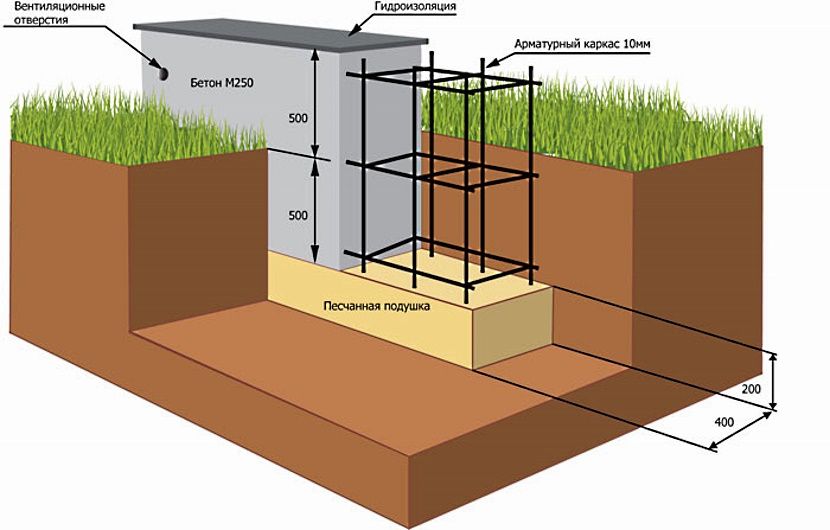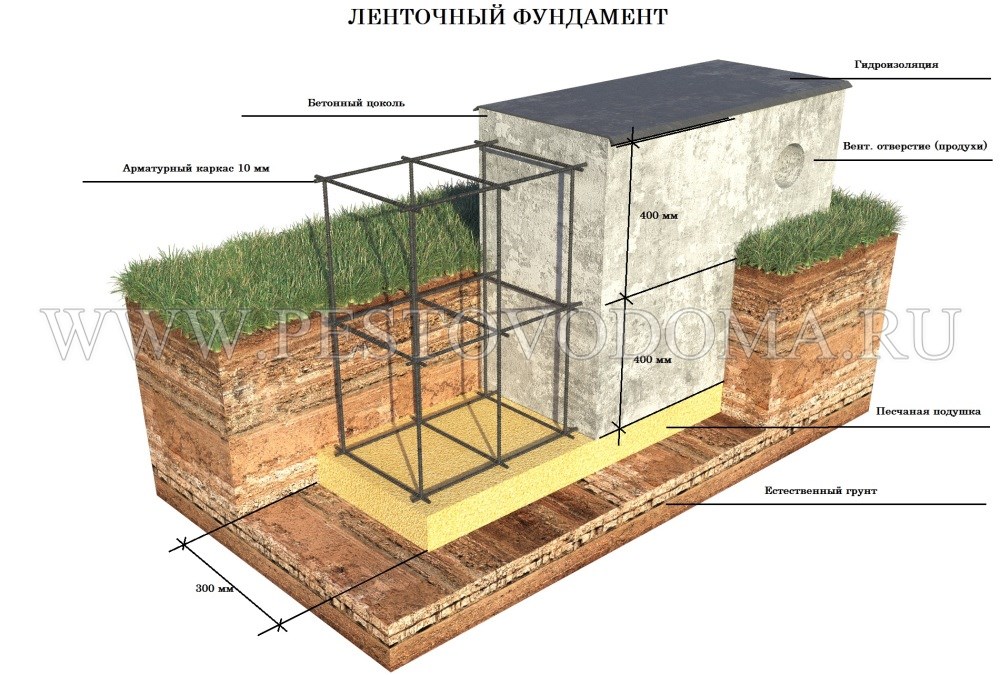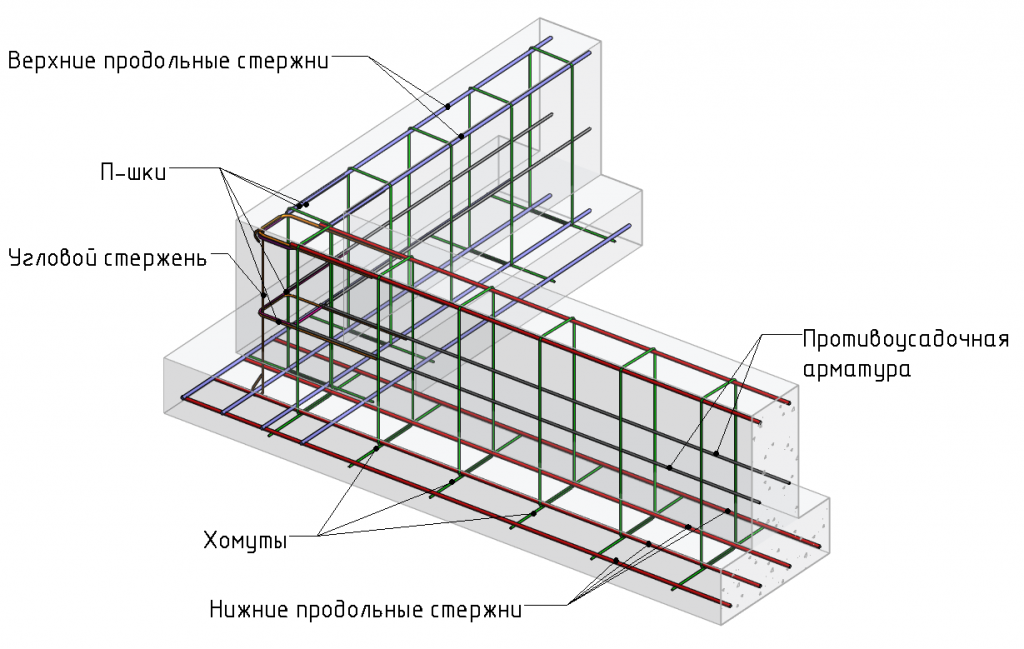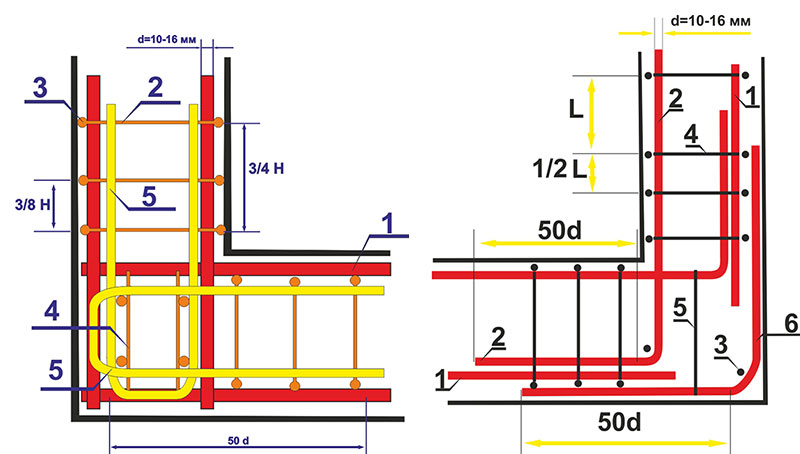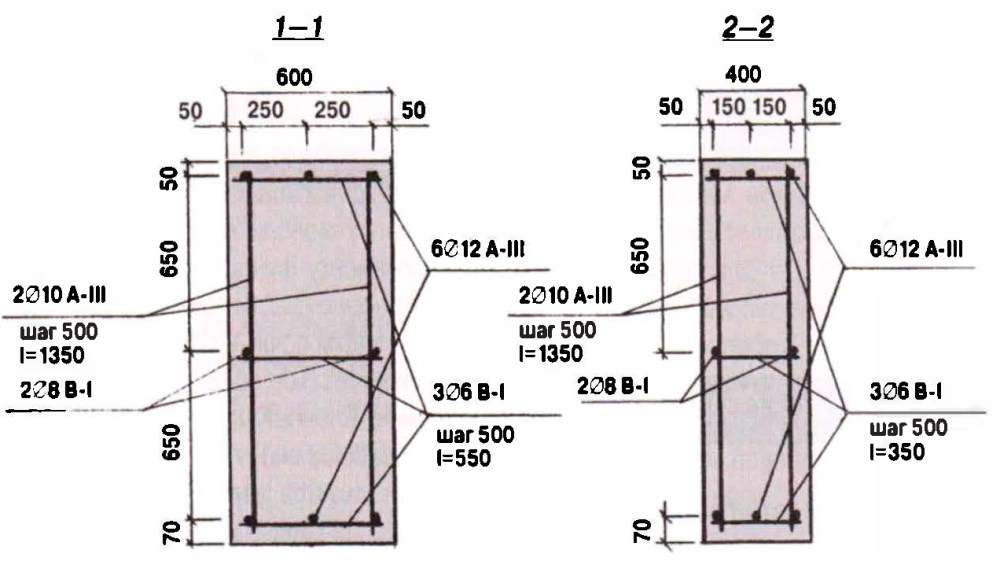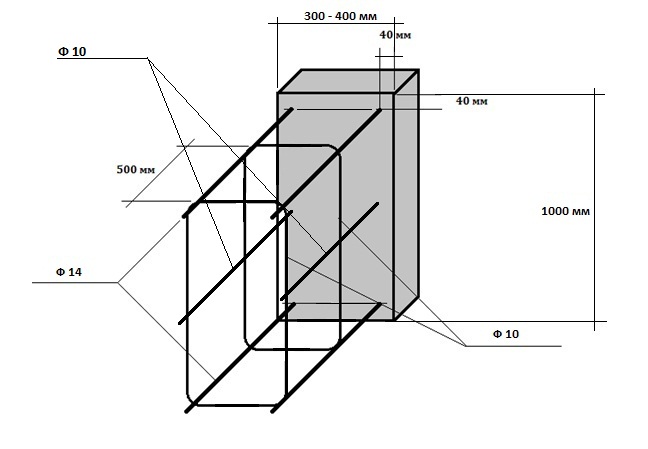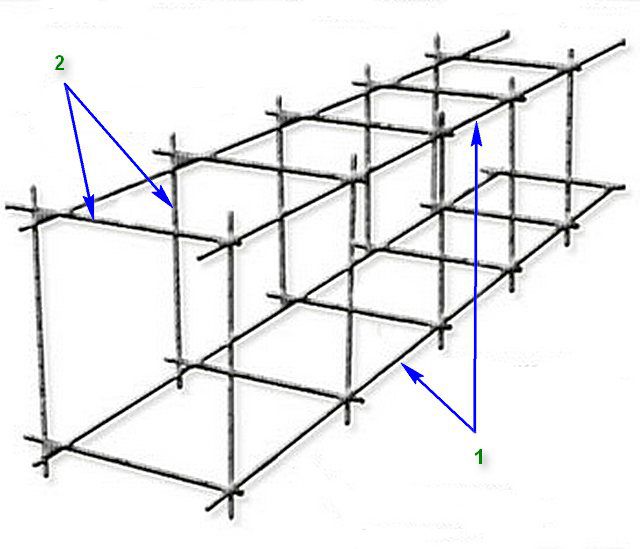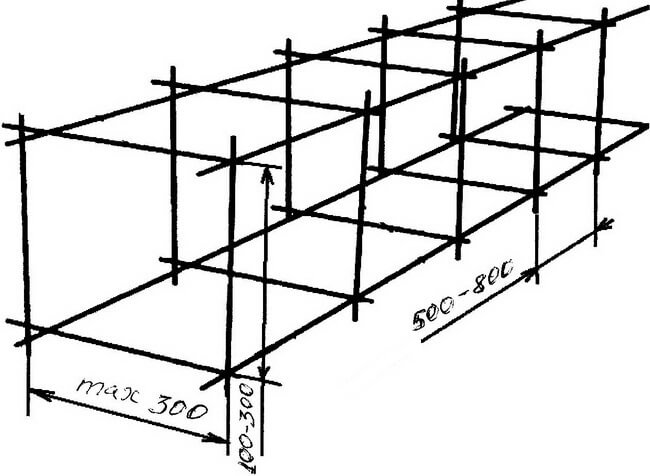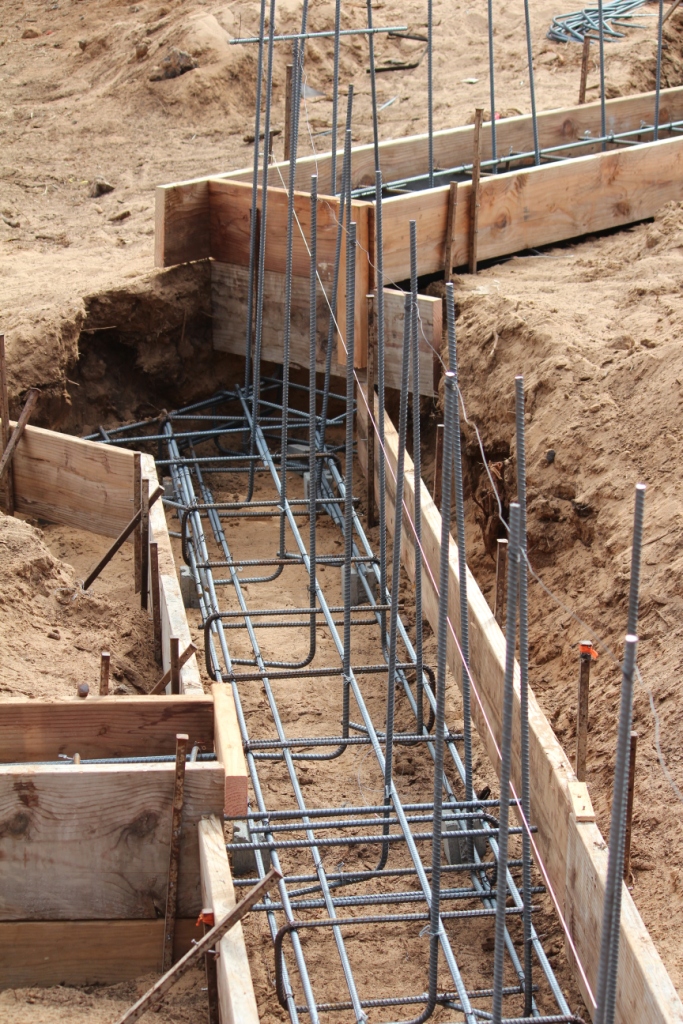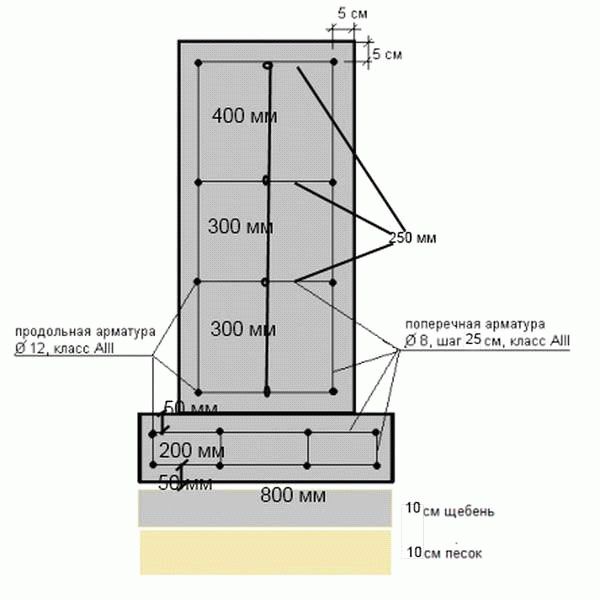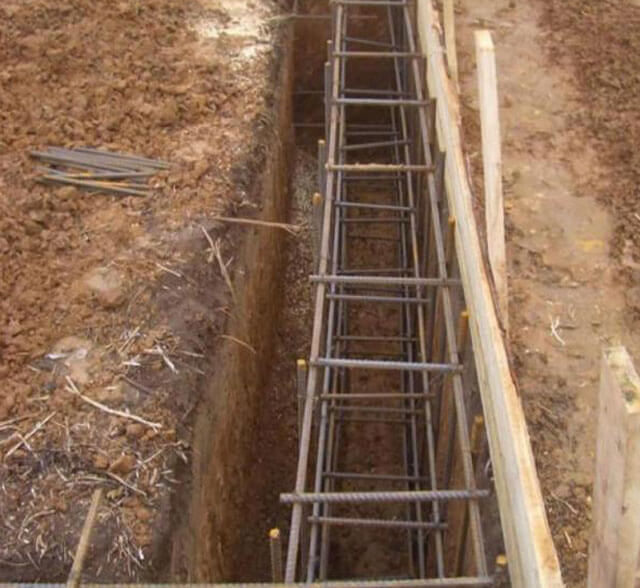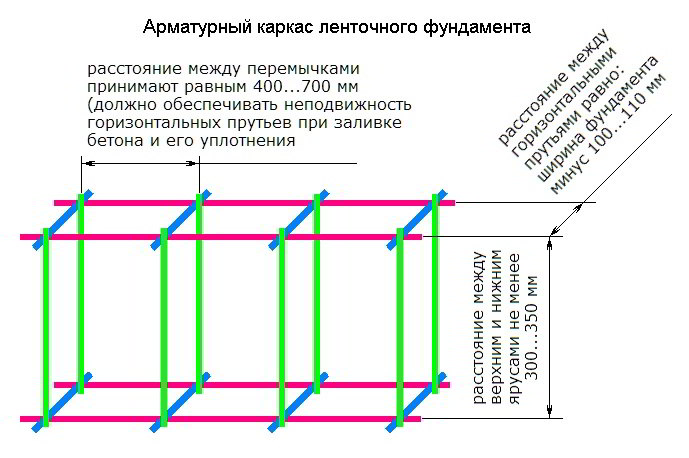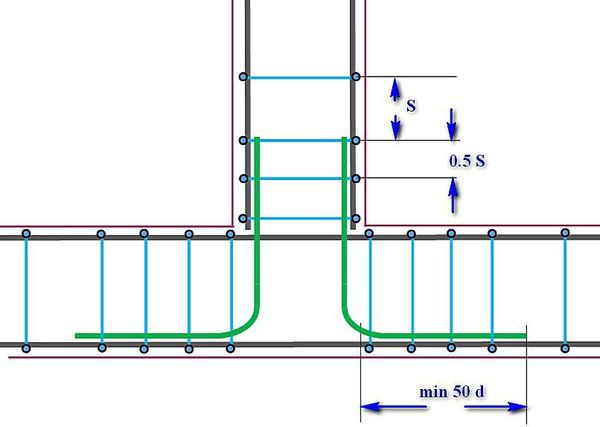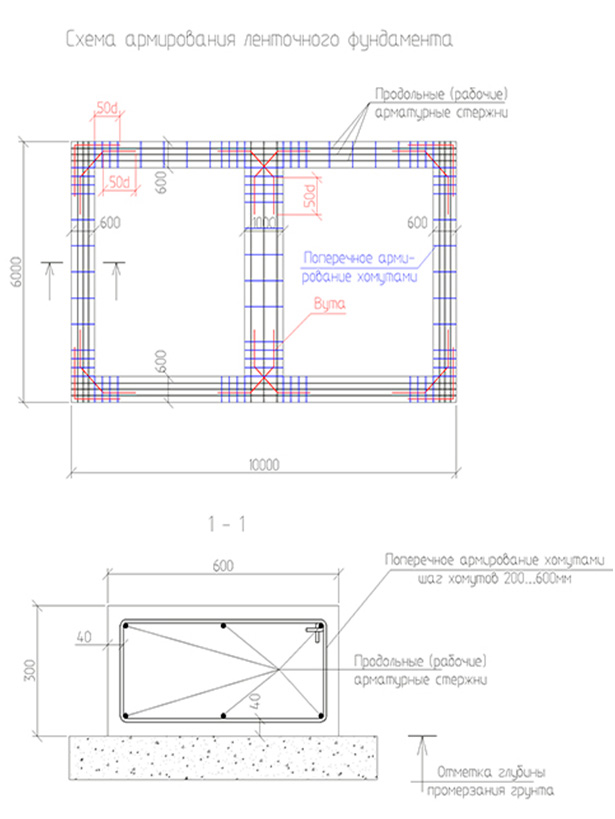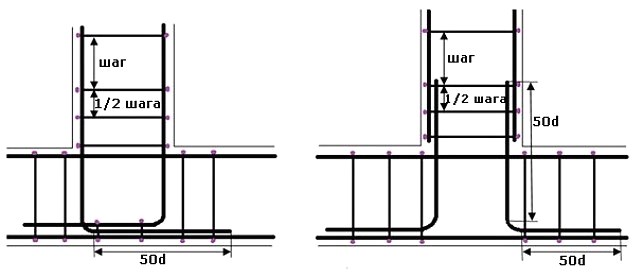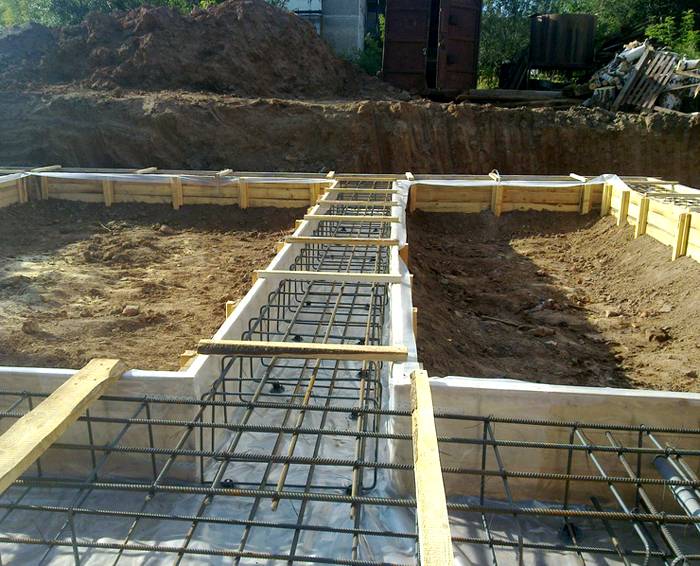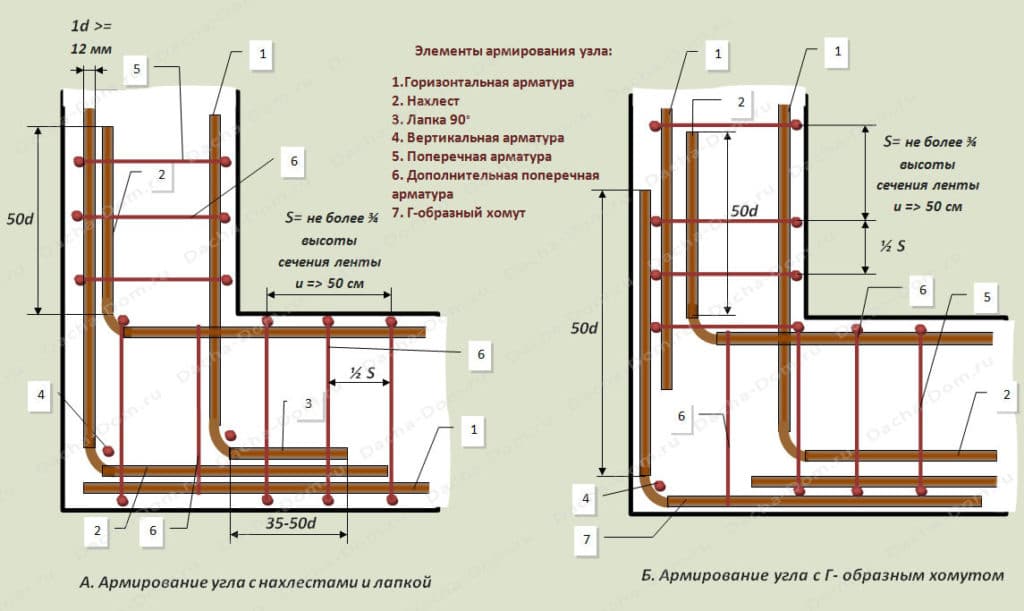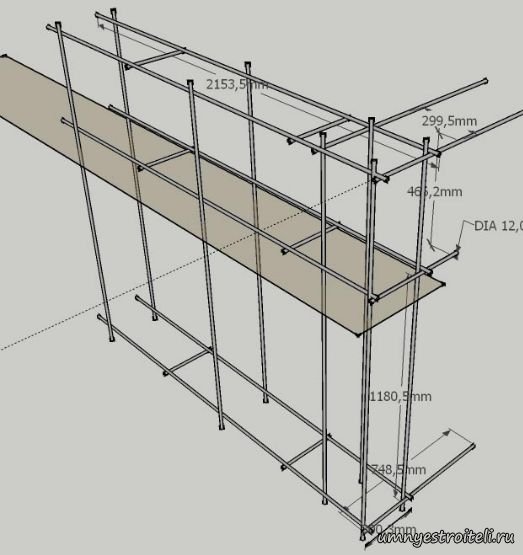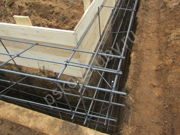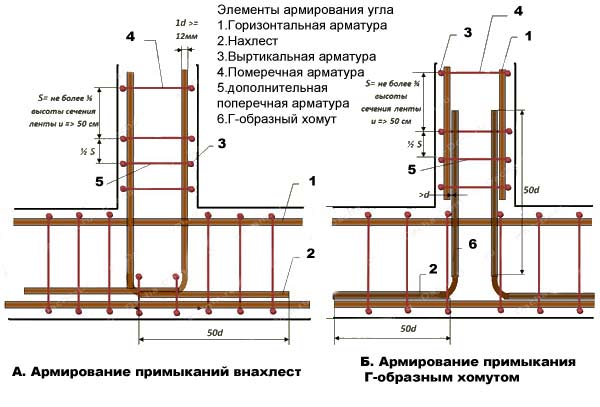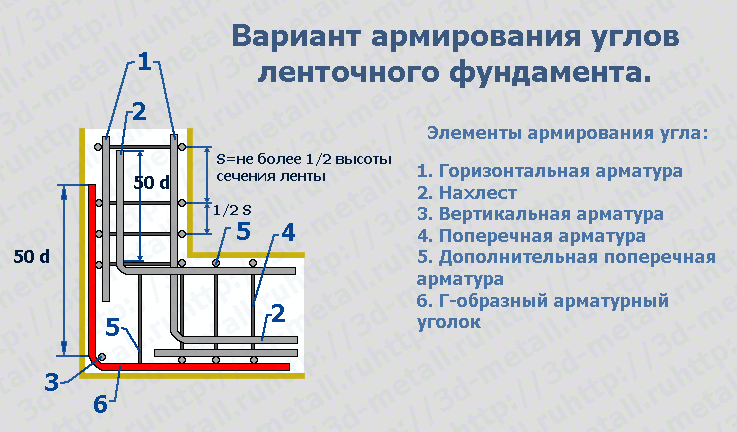IS IT POSSIBLE TO DO WITHOUT VALVES IN THE FOUNDATION
A foundation without reinforcement turns out to be completely inappropriate if the soils on the building site have some mobility. A strip foundation without reinforcement can simply be torn apart by ground movements.
Is it possible not to reinforce the strip foundation?
Strip foundation without reinforcement
For some types of soils, absolutely not. There is a good example in which a person decided to build a foundation on clay, in an area where most are built on piles. As a result, its strip base was torn in several places the very next season. The reinforcement in the foundation not only strengthens the strength, but also gives elasticity.
A strip foundation without reinforcement has a reduced service life in most cases.
Do you need reinforcement in a strip foundation?
In most situations, you need it. There is no alternative. Saving on fittings is inappropriate here. Moreover, the optimal way of fastening the reinforced frame is knitting. With the help of a special binding wire, you can quickly create a high-quality and durable frame. If the joints are fastened by welding, then the structure of the rod is disrupted. A foundation without reinforcement in the process of obligatory shrinkage, which lasts about 5 years, is likely to crack. Therefore, saving on the material of the frame is unacceptable.
Can a foundation be poured without reinforcement?
Technically, this is quite possible and has been done many times. But you should understand exactly how the reinforcement at the base of a building or structure works. It prevents the shear forces that develop during frost heaving from damaging the integrity of the base.
This means that the foundation may not have a frame only in the absence of ground movements. Otherwise, it is required.
The procedure for performing the reinforcement of the strip foundation
The existing scheme for reinforcing the strip base for building a house implies following several mandatory rules:
- Application when carrying out reinforcement of bars of class A400
- Minimization of the use of welding when joining the rods, as this technology contributes to the weakening of the sections
- At the corners, the frame can only be tied, the use of welding at the corners is not recommended
- The protective laid layer of concrete used in a particular situation must be at least 4 centimeters to protect metal elements from negative environmental influences, corrosion
- The use of smooth reinforcement is not recommended.
- When laying concrete, it must not be able to get stuck between the rods, which will eliminate control over failure, for too frequent arrangement of metal rods
Detailed step-by-step instructions with photos and videos given for clarity will help to create a reinforcing cage. A significant advantage of reinforced strip foundations is the combination of high reliability and affordable cost. Steel and concrete are high strength materials.
This is important for creating a foundation for construction on any soil, except for the already naturally stable and reliable rocks. In other situations, any foundation reinforcement will save you from damage caused by stress.
How is formed
When carrying out work such as strip foundation reinforcement, drawings include three groups of rods:
- Used for laying along the belt, used working rods
- Horizontal elements located transversely
- Vertical options, transverse
The task of the transverse reinforcement is to connect all working elements into a stable in use, a single unit of reliable, innovative working rods. They are often called clamps.
An important feature of the work is the use of SNIP and other regulatory specialized documents in activities such as reinforcement of the strip foundation. The calculation uses SNiP 52-01-2203
In this regulatory document, it is easy to find all the necessary calculations to create the reinforcement of the strip foundation of a small country house.
What are the requirements for concrete determined by regulatory documents?
If you maintain the order of creating reinforcement, it is important to comply with the mandatory requirements for the concrete used in a particular job. When creating a strip foundation with your own hands at the site of future construction, it should be borne in mind that among the main characteristics of the strength of concrete structures is an indicator of resistance to axial compression, readiness to resist stretching and not respond to transverse fracture
Correction factors for reliability can vary from 1 to 1.5
When creating a strip foundation with your own hands at the site of future construction, it should be borne in mind that among the main characteristics of the strength of concrete structures is the indicator of resistance to axial compression, the readiness to resist stretching and not respond to transverse fracture. Correction factors for reliability can vary from 1 to 1.5.
Requirements for fittings
These indicators are determined by regulations and standards. Reliable foundation reinforcement uses bar-based:
- hot-rolled rebars,
- mechanically hardened fittings
- heat treated reinforcement
It is GOST that allows you to calculate the indices of the limiting submerged states, which are strictly divided into groups in it. Indicators are determined on the basis of the requirements specified in state standards, which are determined on test benches. Any normative and technical documentation, which is used in determining the reliability of reinforcement, must be approved by the official supervisory authorities.
What basic rules are important to consider when performing work?
As a rule, reinforcement during suburban and construction is carried out independently. In this case, the requirements of SNiP and GOST are not always followed so carefully.
For this reason, when considering how to reinforce a strip foundation with your own hands, it is important to adhere to some mandatory rules:
- When performing the reinforcement of the strip foundation of the future structure, including 1-2 floors, rods with a diameter of 10-24 mm are used.
- The use of welded joints is not recommended
- When creating a strip foundation with your rivers, it will be necessary to create a formwork
Reinforcement scheme
An example of a diagram (drawing) of reinforcement of a slab foundation.
Reinforcement of a reinforced concrete slab is carried out unevenly: additional reinforcement is required in the places of support of walls or columns. Such areas are called punching shear zones. Reinforcement is laid in one layer with a slab thickness of 150 mm or less. With a value of more than 150 mm, the reinforcement is performed with frames. As an example, it is necessary to consider the main components of the structure.
Main slab width
Here the circuit is a grid with a constant cell size. The spacing of the rods in both directions must be the same. Depending on the design load, it is taken in the range of 200-400 mm. For brick houses, a reinforcement pitch of 200 mm is suitable; for lighter frame houses, you can lay the rods less often
It is important to take into account that according to the joint venture "Concrete and Reinforced Concrete Structures" the distance between the rods should not exceed the slab thickness by 1.5 times
Reinforcement scheme for the slab.
Most often, the rods are laid in two rows: upper and lower. Their joint work is ensured by the installation of vertical rods. The pitch of such rods can be equal to the pitch of the main reinforcement or be taken twice as large.
From the ends, the plate is reinforced with U-shaped clamps.
According to SP 63.13330.2012 (clause 10.4.9), at the ends, the slab must be reinforced with U-shaped reinforcement bars, the length of these bars must be equal to 2 plate thicknesses or more. The rods connect the upper and lower rows of reinforcement and provide the perception of torques at the edge of the slab and anchoring the ends of the longitudinal reinforcement.
Attention! The reinforcement should be recessed into concrete by 20-30 mm from all sides: from below, from above, from the ends. Otherwise, accelerated corrosion of the reinforcement and destruction of the structure is possible.
Punching shear zones
In the places where the supporting vertical structures are supported, the layout changes - the step of reinforcement is reduced. For example, if the rods were laid every 200 mm along the main width of the slab, then it is recommended to use a step of 100 mm under the walls. This will avoid excessive punching and cracking.
Zone of conjunction with a monolithic basement wall
The design of the slab allows it to be made flush with the ground, but if a basement is planned in the building, its depth will depend on the height of the room. In this case, it is necessary to ensure the joint work of the base and the walls.
Reinforcement outlets in a slab for joining with monolithic walls.
To properly reinforce the foundation, it is necessary to tie the monolithic wall and slab frames together. When pouring the foundation, the outlets are left in the form of vertical rods, they will be the connecting link. The ends of the outlets are launched into the body of the plate (bent at the end by 2 plate heights and knit to the main frame).
For convenience and accurate calculation of materials, a drawing is performed, which shows a reinforcement diagram, including data on the distance between the rods and their diameters.
Choice of fittings
In the manufacture of steel reinforcement, GOST 5781-82 * is followed. For a reinforced concrete monolithic slab, rods of the A400 class (or, in the outdated version, Alll) are used. In order not to be mistaken, you need to know how to visually distinguish rods of different classes.
- A240 (Al) has a smooth surface;
- A300 (All) is characterized by a periodic profile with a ring pattern;
- A400 (Alll), which is required, has a periodic herringbone (crescent) profile.
Important! The use of fittings of lower classes is not allowed. We recommend: What kind of reinforcement is needed for the foundation
We recommend: What kind of reinforcement is needed for the foundation.
Reinforcement class and steel grade
By the class of reinforcement, one can judge the strength of the material. Along with the new marking, the old one is still used, therefore we will mention both:
- A240 (according to the old GOST - AI) is a hot-rolled steel with a smooth surface, diameter - 6-40 mm. Reinforcement with a diameter of up to 12 mm can be supplied in coils and rods, more than 12 mm - only in rods. It is not suitable for the construction of a foundation as a working armature, but it can be used for clamps;
- A300 (AII) - reinforcement with a ring-shaped profile, it is not recommended to use it when erecting a foundation, but in private construction for small buildings and irresponsible objects it is still used. Naturally, it can be used as structural reinforcement;
- A400 (AIII) and A500 are ideal for foundations. The rods have a relief, the diameter ranges from 6 to 40 mm, the length is from 5 to 11.7 m;
- А600 (АIV) - reinforcement of increased strength, used in the construction of critical facilities, suitable for structures with prestressing;
- reinforcement A800 (AV) and A1000 (AVI) are used in the construction of multi-storey buildings, bridges and other structures, where special strength is extremely important.
In addition, during the construction of the foundation, other types of steel reinforcement are used, the properties of which can be judged by the marking:
- the letter C indicates the ability to fasten the rods into the frame by welding (examples - А400С, А500С, А600С). The A500C class fittings have recently become especially popular;
- the letter K speaks of resistance to corrosion (A400K, for example);
- AT in the marking means that the steel has been thermomechanically hardened.Intermittent cooling, which is used with this technology, increases the strength and resistance to corrosion. A popular class of such fittings is AT800.
GOSTs and TUs require the use of steel of a specific grade for the production of a certain type of reinforcement. The manufacturer must indicate what steel he used - this is very important information for the developer, allowing him to correctly perform all the necessary calculations.
Some of the steel grades used are shown in the table below. The characteristics of each brand are the topic of a separate article. Here we only note that, for example, steel 35GS is low-alloyed, and steel 25G2S is made using silicon and manganese as alloying additives. Both of these alloys are characterized by high strength.
How to choose fittings
When choosing reinforcement for overlap, the following rules should be taken into account:
- If the base is reinforced in a one-story house or a two-story building, reinforcement of 10-24 mm diameter is taken. If we take a thicker diameter of the reinforcement, a durable material - this pleasure is expensive. And the strength itself will not be used on the entire scale.
- It is optimal to take exactly the corrugated type of reinforcement. So it is more securely attached to concrete and provides complete reliability. Smooth reinforcement is inexpensive, but it does not provide the necessary grip and level of strength. An exception is the cross-type connection.
- In case of homogeneous soil, reinforcement of 10-14 mm section is used. If the soil is heterogeneous, then the load increases and the section is chosen in a diameter of 16 - 24 mm.
Undoubtedly, the purchase of a thick, corrugated type of fittings is a rather expensive pleasure. But if the reinforcement of your house in the country or a bath is carried out with your own hands, the amount of work in this case is small and, accordingly, their cost will not be too budgetary.
Rules for carrying out the reinforcement of the strip foundation
How, according to building codes, to properly reinforce and strengthen the strip foundation in the structure? So the rules according to the norms for the safe construction of the foundation are as follows:
if working reinforcement is applicable - bars of class at least A400 are applicable;
it is not recommended to use welding - it will simply weaken the section and accordingly reduce the fight with concrete;
the metal frame at the corners is bound without fail - welding in this place is also unacceptable;
even when choosing a clamp - it is forbidden to choose models with a smooth surface of the reinforcement;
the protective layer in the concrete structure must be observed - it is 4 cm, and it is he who protects the reinforcement from corrosion and destruction;
when installing the rod in the longitudinal direction - they must be connected with an overlap equal to at least 20 diameters of the selected rod, and not less than 25 cm;
if the metal is often located in the structure, it is important to control the size of the aggregate in the concrete composition itself, which should not get stuck between the rods;
How the reinforcement is knitted - it is the tying method that is mandatory, since it is such a frame that acquires greater strength, especially in comparison with the welded one. This is due to the high probability of unnecessary burning of the metal itself, although this rule is not extended to factory structures.
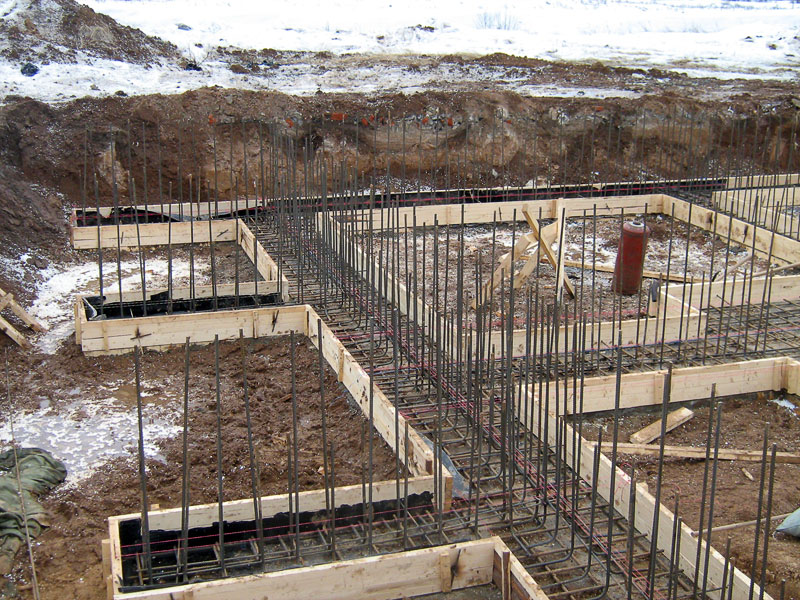 Figure 3. Knitting reinforcement
Figure 3. Knitting reinforcement
Reinforcement laying
At the same time, the corners of the frame are also knitted - no welding with a knitting one, a wire is specially provided
Before carrying out all construction work in the process of laying and strengthening the strip type of foundation, it is important to prepare the tools. In practice, two laying methods are used:
- use special hooks in the process;
- or it can use a more modern and portable tool - a knitting machine that works on the principle of a pistol.
So in the first version, the hook is more suitable for erecting a foundation of a small volume, but laying the reinforcement itself with this method of knitting takes a lot of time. For the connection, it is optimal to use an annealed wire with a diameter of 0.8 to 1.4 mm. The use of other materials for binding is simply unacceptable, since most of them are not able to withstand the weight of the structure.
What is reinforcement and why is it needed?
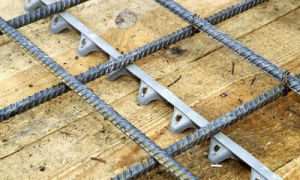 Rebar tying
Rebar tying
Reinforcement is the increase in the strength of a concrete base using metal reinforcement. This technique allows you to avoid the formation of cracks in the foundation, increase frost resistance and prevent deformation.
Reinforcement is made with a special steel structure, which is then poured with concrete.
There are three types of building reinforcement:
- The horizontal type is the most common, it is he who will evenly distribute all the loads over the foundation during the operation of the building and shrinkage;
- Vertical reinforcement is used less often, it serves only as an additional element of strength;
- Mixed reinforcement is usually used in the corners of the house to increase the stability of the frame.
Typical mistakes
All methods of corner and adjacent reinforcement joints are aimed at maintaining the integrity of the reinforcement cage, regardless of its configuration. The strength of the strip foundation depends on the correct anchoring of the end pieces of the longitudinal reinforcement. The following schemes lead to incorrect reinforcement of the corners of the strip foundation:
1. Reinforcement of the corner zones of the strip foundation with reinforcing crosses with viscous longitudinal reinforcement bars at right angles.
2. Installation in corner and adjacent zones of bent longitudinal reinforcement without anchoring.
These errors are the most common and can lead to the destruction of the foundation in the places of corner joints and abutments.
Corner and adjoining joints made by knitting the crosshairs of longitudinal reinforcement bars
A typical mistake in reinforcing corners and junctions is the connection of longitudinal reinforcement using the crosshair knitting method. Such a reinforcing connection without proper anchoring of the rods can lead to the destruction of the concrete monolith due to multidirectional loads arising at the corners of the strip foundation.
Rice. 9. A common mistake when reinforcing corners
The use of bent longitudinal reinforcement for the reinforcement of corner joints and abutments
1. Corner joints without a bundle of internal and external longitudinal reinforcement (1) do not provide rigid bar fixation.
2. The destruction of the foundation can occur not only due to the formation of transverse cracks, but also due to the flaking of the inner corners.
Rice. 10. Another example of incorrect corner reinforcement
Be sure to read: Is it possible to reinforce a strip foundation with fiberglass reinforcement, if you are going to use it.
In order to prevent the formation of cracks, spalling and delamination at the corners and abutments of the strip foundation, it is necessary to correctly tie the end rods of the longitudinal reinforcement and perform their reliable anchoring. Correct reinforcement of the corners of the strip foundation is the key to the reliability and durability of the building.
Good publicity
Knitting reinforcement using a special device - a knitting machine
To create this tool, you need to take several boards 20 millimeters thick, cut 4 boards along the length of the reinforcement, connect two at a distance equal to the step of the vertical posts, creating 2 identical templates. Next, two vertical supports are made with a height equal to the height of the reinforcement mesh. Supports are constructed with lateral corner stops; it is better to choose a flat platform for work.
The device is used as follows: the legs of the stops are installed on two knocked down boards, the two upper boards are placed on the upper shelf of the stops, fixed. That's it, the reinforcement mesh layout is ready, now you can knit quickly.It is enough to put the vertical struts of the reinforcement in the marked places, fixing them with nails, install the rods on each steel lintel, doing so on all sides of the frame. Next, we take the hook and wire - everything, you can knit. Such a device is relevant where it is planned to create many of the same type of mesh sections.
Reinforcement scheme
For a private country house, two reinforcement schemes are used, which are performed with four or six stitches. The second option is used for a foundation more than 0.5 meters wide.
Rebar rods are driven into the soil with a length equal to the depth of the foundation. Waterproofing materials are laid out at the bottom of the formwork and bricks are laid. A reinforced mesh or frame is installed on top. For knitting the frame, the reinforcement bars are tied into square cells, which are tied with wire.
The length of the side of the cell is 30-60 cm. The mesh is installed 50-70 mm from the edges of the trench. The mesh is laid in two rows of two or three threads. The rows are attached to the vertical posts with a knitting wire. After reinforcement, do not forget to make ventilation and sewer holes, only then fill the formwork with concrete.
Masters of "MariSrub" will select a suitable type of foundation, perform reinforcement and installation of the structure, calculate the amount of construction and consumables, install ventilation and sewerage systems. We build quality and reliable wooden houses from logs and beams on a turnkey basis or for shrinkage!
Reinforcement requirements
To understand what kind of reinforcement is needed for a strip foundation, it is necessary to perform calculations and consider the main types of material. To perform the work, mechanically hardened, hot-rolled construction heat-treated reinforcement is used. The class is chosen according to the maximum loads, taking into account the tensile characteristics, ductility, weldability, corrosion resistance, the ability to withstand temperature differences, etc.
The main brands of rods: hot-rolled rod (A), cold-deformed wire (Bp), very strong rope (K). For the frameworks of the foundation, rods of class A400 (AIII) yield strength with a crescent herringbone pattern are selected.
Correct reinforcement involves the use of these types of rods:
- Workers - for perimeter stacking
- Transverse vertical
- Cross horizontal (clamps)
- Additional - usually used instead of knitting wire
To understand which fittings are best to use, you need to remember some rules. To strengthen the base of one-, two-story buildings and light structures, rods with a diameter of 10-24 millimeters are suitable. The strength characteristics of thicker (and much more expensive) reinforcement are unlikely to be used.
The rods must be grooved, as they provide excellent adhesion to the concrete mortar, their thickness must clearly correspond to the values specified in the documents. Smooth rods are cheaper, but they will not allow you to create a reliable and durable reinforcing cage. They can be used only in transverse joints, where a not very large load is noted.
When creating a strip foundation frame on a homogeneous soil, you can choose a material with a diameter of 10-14 millimeters, on a heterogeneous one - 16-24 is better. If the side of the building is more than 3 meters, the working reinforcement of the monolithic foundation is made from rods of at least 12 millimeters, but not more than 40.
The technology requires that horizontal clamps in diameter are not less than a quarter of the working rods - they usually take 6 millimeters. Vertical rods for low-cut foundations of 80 centimeters or less should be at least 6 millimeters in cross section. Having thought everything over, you can determine what diameter of the rods is needed for different types of work.
Reinforcement scheme
The number of longitudinal rods located depends on the width of the strip foundation; in individual construction, two options are common: with four and six rods. The second system is relevant when the size of the monolith exceeds 50 cm. This is due to the basic requirements for the placement of reinforcement, according to SNiP 52-101-2003: the distance between the longitudinal lines should not exceed 40 cm; the recommended gap between the metal frame element and the edge of the concrete is 5-7 cm.
It is impossible to recessed the rods in the center, as well as to allow them to be located near the ground due to the increased risk of corrosion. An additional rod is fixed exactly in the middle, the distance between the lower and upper chord varies within 60-80 cm, this scheme is ideal for the foundation of a one-story house no more than 1 m high.Transverse and vertical rods cross each other in one node, the placement interval is from 30 up to 80 cm, for convenience of calculation it is often taken equal to 50.
The corners require special attention; in the areas of stress redistribution, the frame is reinforced with curved rods. Recommended schemes include anchoring with L-shaped or U-shaped elements, or bending of a longitudinal row. The supporting reinforcement is laid in the upper belt, the minimum length of one side is 50 cm.Also, in these areas, the interval for placing longitudinal rods is reduced, the step for foundations of a standard cross-section is 25 cm. corners are not enough.
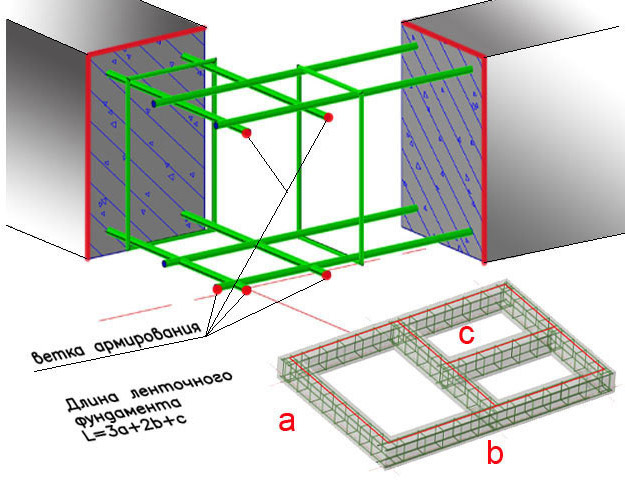
Calculation of reinforcement for strip foundations
The initial data are the geometric dimensions of the future base. The calculation is carried out at the design stage of the house, simultaneously with the drawing up of the arrangement of the rods. The process begins with the choice of the diameter; for a strip type of foundation, it is allowed to use different types of hardware for longitudinal (main) rows and vertical with transverse ones. The minimum laid for horizontal bearing rods is 12 mm, an exception is made for light buildings such as a bath (but not less than 10 mm). Reinforcement of the same section with one steel grade is used; in case of excess, it is allowed to lay products with a large diameter to form the bottom row.
Knowing the size of the tape perimeter and the number of rods, at first glance, it is easy to find the total footage. But the calculation is complicated by the need to use one-piece fittings. Ideally, the longitudinal rods are inseparable, with a bunch of two segments shorter than the length of the wall, the allowable minimum margin is 30 cm.The curved elements for reinforcing the corners are not inferior in diameter, their total footage depends on the number of turns, the calculation includes areas of contact with internal load-bearing walls ...
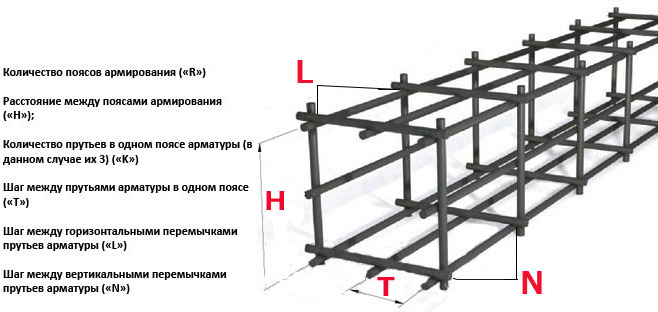
The required length for transverse and vertical bars is also calculated according to the selected scheme. The easiest way is to calculate the footage per joint and multiply it by the number of nodes. Even if the frame is connected by welding, the reinforcement for the foundation is not cut to the ground, taking into account overlaps and starts is required. It is impossible to accurately take into account the size of the protruding segments; to simplify the calculation, they are taken equal to 10% of the total footage of the mounting rods.
The nuances of knitting reinforcement
The welding joint for the frames of strip foundations is not suitable: in addition to increasing costs, it does not provide sufficient reliability, the joints corrode over time. The only possible fixation method is considered to be strapping with plastic clamps or steel wire. Its calculation is simple: the number of nodes is multiplied by the length of the segment required to grip the rods and twist the ends (usually 30-50 cm), the resulting footage is converted into kg.
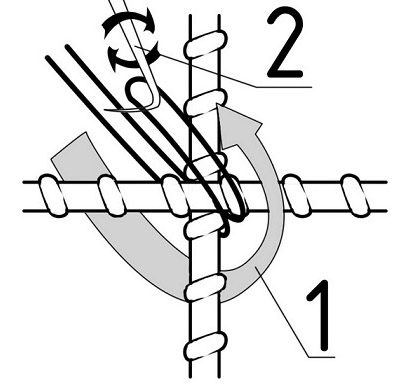
The recommended wire cross-section with a reinforcement diameter of 12 mm varies from 1.2 to 1.4 mm. Crochet is used for knitting and pliers or a special pistol (an expensive tool, but justified for large volumes of work).
Calculation of working reinforcement
When erecting serious structures, detailed calculations of the strip foundation are required, which will accurately determine which reinforcement to use for a given structure. All calculations in construction are carried out according to limiting states, that is, the minimum conditions are determined in which the element will perform its function.
- The first group of limiting states is strength analysis. Reliability and safe operation of the structure is ensured.
- The second group of limiting states is stiffness calculation. Prevents excessive crack opening, distortions, large deflections.
Calculations using these formulas are laborious and require technical education. To simplify the design of small private buildings, the strip foundation reinforcement is taken based on the minimum values.
An example of calculating bars for a strip foundation
Initial data:
- belt height - 100 cm;
- tape width - 40 cm.
It is required to design a frame for an individual residential building. Longitudinal, transverse and vertical reinforcement is used. The vertical one is taken with a cross-section of 8 mm and is installed with a step of 25 cm. The transverse horizontal is mounted with the same step, but with a diameter of 6 mm.
In order to determine which working armature is needed, a simple calculation is performed
- Cross-sectional area of the foundation = width * height = 100 cm * 40 cm = 4000 cm².
- Required cross-sectional area of reinforcement bars = 0.1% * 4000 cm² = 4 cm².
Further, to determine which reinforcement to use, you need to refer to the assortment. The number of rods is taken to be even in order to evenly distribute them in the lower and upper horizontal layers.
| Rebar diameter, mm | Total calculated cross-sectional area of reinforcing bars, cm2 | Weight of 1 meter of reinforcement, kg | ||||
| 2 rods | 4 rods | 6 rods | 8 rods | 10 rods | ||
| 8 | applies only with a foundation height of 15 cm or less, which is not suitable for tape structures | 2,01 | 3,02 | 4,02 | 5,03 | 0,395 |
| 10 | 3,14 | 4,71 | 6,28 | 7,85 | 0,617 | |
| 12 | 4,52 | 6,79 | 9,05 | 11,31 | 0,888 | |
| 14 | 6,16 | 9,23 | 12,37 | 15,39 | 1,21 | |
| 16 | 8,04 | 12,06 | 16,08 | 20,11 | 1,58 | |
| 18 | 10,18 | 15,27 | 20,36 | 25,45 | 2,0 | |
| 20 | 12,56 | 18,85 | 25,13 | 31,42 | 2,47 |
For this strip foundation, the minimum diameter is 12 mm according to the document “Reinforcement of elements of monolithic reinforced concrete buildings. Design Guide ", and we accept it. According to the assortment, 4 rods are required: 2 are located at the bottom and 2 at the top.
Calculation of the number of reinforcement per foundation
Initial data:
- the materials are indicated in the previous paragraph;
- the length of the walls of the strip foundation - 40 m.
It is required to calculate the mass of reinforcement of all diameters for a strip foundation.
- Length: perimeter of the building * number of rods in the section + margin for overlap when welding rods = 40 * 6 + 5 = 245 m.
- Anchorage of corners: number of bars in the section * number of corners * minimum anchorage length (50 reinforcement diameters) = 6 * 4 * (50 * 12) = 14.4 m.
- Mass: length * mass of one meter = (245 + 14.4) * 0.617 = 230.3 kg of rods with a diameter of 12 mm.
Constructive horizontal reinforcement
The length of the rods is taken depending on the width of the tape wall minus the protective layer of concrete - 2-3 cm on each side. We accept longitudinal rods 34 cm.
- Number of rods: perimeter of the building / step of the clamps (in the previous paragraph it was assumed 25 cm) = 40 / 0.25 = 160 pcs.
- Total length: quantity * length of one rod = 160 * 0.34 = 54.4 m.
- Weight: 54.4 * 0.222 (not indicated in the table above, but available in the full range) = 12.1 kg of rods with a diameter of 6 mm.
Structural vertical reinforcement
Everything is as in the previous paragraph, the rods are set with a length equal to:
The height of the strip foundation minus 3 cm * 2 = 100 - 3 * 2 = 94 cm.
- Number of rods: perimeter of the building / step of the clamps (in the previous paragraph it was assumed 25 cm) = 40 / 0.25 = 160 pcs.
- Total length: number * length of one rod = 160 * 0.94 = 150.4 m.
- Weight: 150.4 * 0.395 = 59.41 kg of rods with a diameter of 8 mm.
For convenience, the figures obtained can be summarized in a table.
| Appointment | Diameter | total weight |
| Working | 12 mm | 230.3 kg |
| Transverse | 6 mm | 12.1 kg |
| Vertical | 8 mm | 59.41 kg |
We recommend reading:
Calculation of the diameter of the reinforcement takes no more than 10 minutes, but it will avoid overspending of material or the cost of repairing strip foundations. The table obtained in the last paragraph is convenient to use when purchasing material.
Good publicity
Reinforcement requirements
Before reinforcing, you need to decide on what dimensions the frame will be, make a drawing, draw a diagram of all work and structures. The geometric dimensions of the foundation must be such that the location of the reinforcement is free. The concrete layer completely covers the frame, protecting it from external influences and corrosion.
The minimum distances between the rods must be sufficient for effective joining and compliance with all the rules of technology. Only high-quality fittings are used in the work, in accordance with SNiP 3.03.01. The bending of the rods is carried out using special devices. The bend radius corresponds to the diameter and physical parameters of the bars.
And one more useful video:

